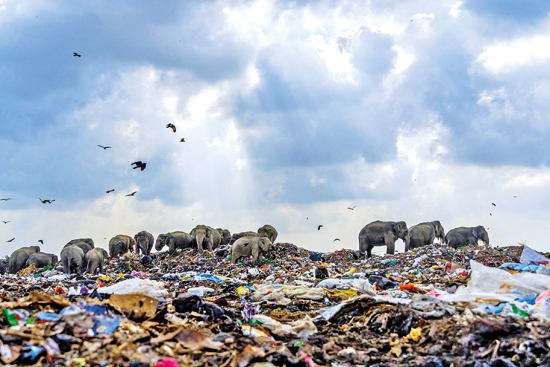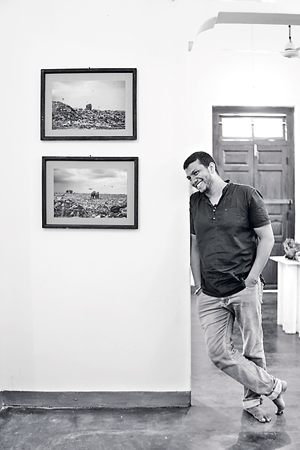Tilaxan’s effort to capture plight of elephants wins award
Tharmapalan Tilaxan’s photograph of a herd of elephants eating from a rubbish dump in the Ampara district has won first prize in this year’s Royal Society of Biology (RSB) photography competition.
 On the evening of February 8, 2020, Tilaxan saw a herd of wild elephants foraging for food in a garbage mound close to the forest bordering the Oluvil-Pallakadu area in the Ampara district. The haunting visual stuck and he began researching and collecting information about Sri Lankan elephants. Travelling from Jaffna to Ampara he spent some 28 days taking photographs, standing amidst the piles of garbage from 7 a.m. to 7 p.m, observing and documenting the herd making their way through mounds of waste, plastic and refuse searching for food.
On the evening of February 8, 2020, Tilaxan saw a herd of wild elephants foraging for food in a garbage mound close to the forest bordering the Oluvil-Pallakadu area in the Ampara district. The haunting visual stuck and he began researching and collecting information about Sri Lankan elephants. Travelling from Jaffna to Ampara he spent some 28 days taking photographs, standing amidst the piles of garbage from 7 a.m. to 7 p.m, observing and documenting the herd making their way through mounds of waste, plastic and refuse searching for food.
The conditions were trying. He found it difficult to breathe because of the stench, he would become dizzy occasionally and he began developing a skin condition.
The series of photographs that emerged from these long, arduous and occasionally dangerous pilgrimages show these magnificent creatures surrounded by a sea of garbage as far as the eye can see – a sobering contrast to the usual visuals of elephants in Sri Lankan travel brochures or wildlife photographs. The photo series went viral and was picked up by international news outlets last week. The winning photograph stands out – elephants on a mound of garbage, encircled by crows while rays of light break through the clouds overhead.

The winning entry (left) and (above) Tilaxan at a recent exhibition of his work
In an article for roar.lk, Tilaxan writes that garbage from Sammanthurai, Kalmunai, Karaitheevu, Ninthavur, Addalachchenai, Akkaraipattu and AlaiyadiVembu is dumped on the site, gradually encroaching on the adjacent forests and attracting the wild elephants of Oluvil to the heap. A fence once erected around the dump is now broken. As a result of this new feeding habit, the elephants consume microplastics and polythene – postmortems on elephant cadavers have shown plastic and non-digestive polythene, he notes in the article.
“The herd of wild elephants—numbering about 40—now accustomed to feeding so close to human habitat have also begun to invade nearby paddy fields and villages seeking more food adding more tension to the already fraught relationship between the villagers and the wild animals,” Tilaxan wrote.
In photography for eleven years now, Tilaxan explains that the award has boosted his self-confidence, giving him an impetus to continue and achieve his photography goals. His photographs draw from the ordinary people around him as well as the interdependent relationship with man and nature – the world is not only for humans, he emphasizes.
“The very early inspiration came from the animal stories which I heard and read in my childhood. These stories made me an animal lover, especially an elephant worshipper. In this background, I was so disappointed because of the killings and unnecessary loss of elephants. The lack of awareness of the state and the general public on this issue made it more sick and sad. This context stimulated me to raise awareness on this issue and apply the environmental photography approach for publicity,” he explains in an email to the Sunday Times.
He hopes the photographs will draw much-needed attention to the issue. “I have documented this in the hope that change will happen. I have raised awareness about this all over the world today. I try as hard as I can … a positive change is bound to happen,” says Tilaxan.
| “Our Changing World”, theme of competition | |
| Tilaxan’s photo was chosen for addressing the Royal Society of Biology’s 2020 competition theme “Our Changing World”. The winner of the Royal Society of Biology’s Young Photographer of the Year award was 14-year-old Ashwin Geerthan, also from Sri Lanka.Ashwin’s award-winning image featured cormorants using man-made objects – poles left by fishermen – to their advantage in order to spot fish in waters. The photograph highlights “how the natural world is adapting to human influence and not just stagnating” explained Ashwin in a video on the Royal Society of Biology’s Facebook page. “The photo I took shows how humans and nature don’t have to be seen as foes but as allies that work together and adapt to survive.”
|


